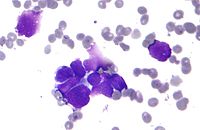
Photo from wikipedia
Cutaneous carcinosarcomas are rare biphenotypic tumors that simultaneously show epithelial and mesenchymal differentiation. The most common carcinomatous components in skin carcinosarcomas are basal cell carcinoma and squamous cell carcinoma; adnexal… Click to show full abstract
Cutaneous carcinosarcomas are rare biphenotypic tumors that simultaneously show epithelial and mesenchymal differentiation. The most common carcinomatous components in skin carcinosarcomas are basal cell carcinoma and squamous cell carcinoma; adnexal carcinomas are rarely encountered. We report a case of an adnexal carcinoma with ductal and squamous differentiation and spindle cell component, which is interpreted as carcinosarcoma. Loss of immunohistochemical expression of E‐cadherin and β‐catenin detected in the sarcomatous component suggested epithelial mesenchymal transition (EMT). RNA sequencing analysis identified several gene mutations and alterations such as translocations and upregulations/downregulations, either shared by the two components of the tumor or differentially present in the carcinoma or the sarcoma parts. Thus, mutations in genes, such as TP53, were found in both components of the tumor while mutations in PDGFRA and RB1 (a pathogenic missense mutation) were exclusively present in the sarcomatous areas, further supporting EMT. EMT is a dynamic process by which tumors acquire mesenchymal phenotype while simultaneously losing epithelial properties. Although the pathways involved in EMT have been extensively studied, this phenomenon still needs to be investigated in cutaneous tumors of adnexal origin for a better understanding of their pathogenesis. These molecular changes may represent promising targets for personalized therapies.
Journal Title: Journal of Cutaneous Pathology
Year Published: 2020
Link to full text (if available)
Share on Social Media: Sign Up to like & get
recommendations!